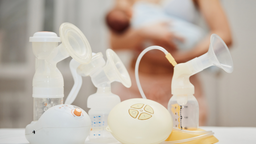If you’re planning to breastfeed, at least two or three nursing bras should be on your essentials list. It’s important to choose a nursing bra to match your lifestyle, your breast size, and your personal preferences.
To help you on your nursing bra selection process, we’ve consulted with Nicole Zoellner, mom and owner of Nizo Wear bras. A nursing bra expert, Nicole offers some tips on fitting a nursing bra, an explanation of different bra types, as well as different bra materials.
WHERE SHOULD I PURCHASE A NURSING BRA?
Wait to purchase your nursing bra until you are into your third trimester as your rib cage will expand during pregnancy. Once you are in your third trimester your band size should remain the same. Most women go up a cup size after their milk comes in. I would look for a bra that is made of primarily cotton so it will breathe, but one that also has some stretch/spandex in it as well to accommodate your changing breast size. So, if you are purchasing your bra before your baby is born I would fit the band and then go up a cup size to what you are currently measuring. The key is in the spandex at this point because your size will change so much in the first couple of weeks. Comfort is number one priority here ladies.
HOW DO I FIT A NURSING BRA?
If you have a professional bra fitter in your area you may want to call upon their services. But, you can also do it yourself at home. Here is how to figure out your size:
Band Size:
Wearing a good supporting bra, stand in front of a mirror and measure straight across the back and over the top of the breasts right at underarm level. It is important that the tape measure is a straight line. If it does not, that will add inches. Having someone help with this will ensure a more accurate measurement. Add one inch to the resulting figure. This figure will be the band size.
Cup Size:
While wearing a good fitting, well supportive, non padded bra measure across the back and over the top of fullest part of your breasts. If the resulting figure is a fraction, then you will round up to the nearest number and add an inch if the number is odd. For instance, for 30 and ½ inches you would round up to 31 and add 1 Inch. If the figure were 27 and ½ you would round up to an even 28.
Take the band size and subtract it from the second figure. The difference between these sizes in inches determines the cup size (1/2-1 = A, 1-2 = B, 2-3 = C, 3-4 = D, 4-5 = E, 5-6 = F).
FITTING TIPS
- A great fitting bra shouldn’t dig, pull, poke or otherwise cause discomfort. If it does, it’s not the right size (or bra) for you. Make sure it feels comfortable when you are moving around.
- There shouldn’t be any breast tissue spillage at the top, side or bottom of the cups. If there is, your cup size is too small. Try sizing up for a better fit.
- Straps shouldn’t work too hard. Your bra’s support comes from the band, not the straps. So be sure that you’re wearing the correct band size. Too big, and your straps will end up taking the weight, which will cause them to put pressure on your shoulders and dig in.
- Is your band straight? Look in the mirror from the side. Your band should be at the same level all the way around your back. If it is riding up in back, it’s probably too big. Try sizing down a band size or tightening your band.
- No gapping: The center front of your bra should lie flat against your breastbone. It should not lie on top of any breast tissue. If there’s a large gap, you may need to go up a cup size.
- Band tightness: Your band should feel firm and secure, but you should also be able to slip two fingers beneath the band in back, and one in the center in front. If you can’t, you may need to loosen your band a bit, or go up a size.
- Underwires: Underwires should lie flat at the front of your bra, against your ribcage. If you feel your underwire digging into any breast tissue, you should try a larger cup size or a different style.
- Bras stretch over time: Be sure you’re wearing your bra on the loosest hook. Your bras can stretch with washing and wear, so when you buy a new bra, it’s best to ensure it fits properly on a loose hook, so you can tighten it as needed.
- A perfect fit: Your breasts will feel like they are “sitting” in the cups, you will not feel any underwire pinching and your bra will feel comfortable and supportive. You shouldn’t have to settle for a so-so fit. Sometimes you will have to go up a cup size or two. Don’t let it concern you – sizes do vary among brands. Finding the perfect bra takes time and patience, but the way you will look (and feel) once you have found it will be worth all of your effort.
STYLES OF NURSING BRAS
Soft Cup:
A softcup nursing bra is designed to be springy and stretch and contract while still fitting well. The most obvious advantage to a softcup nursing bra has to be its comfort. This is the perfect bra for at least the first few weeks, but can be worn longer.
Molded/Padded Cup:
Yes, even the very large breasted nursing mothers choose padded nursing bras for some very good reasons. It’s not about enhancing the size of a nursing mother’s breasts because nursing has done a very good job of that. It’s about style and comfort as well as practicality. A padded maternity bra can help conceal nipples and disguise thicker nursing pads that some moms may need due to leakage especially in those first few months.
Sleep Bra:
Typically sized by S, M, L, XL and is used during sleep or light activity. Many women love this bra for support it provides while sleeping, or it could be to hold in the nursing pads and still allow for comfort or even for everyday around the house wear or for pre-delivery wear for those growing breasts.
Now it’s true that a nursing sleep bra is not built to lift and separate and give your breasts that perfectly holstered look. However, they are engineered for support during sleep (or even activities), and easy access during those late night feedings, especially for larger breasted nursing mothers and to be extremely comfortable for sleeping or around the house wear when there is no need for the more restrictive full nursing bra.
Underwire Bras:
Underwire bras can dig into your breast tissue, clogging a milk duct without your being aware of it. Many lactation consultants prefer nursing mothers to wear softcup bras, especially in the early weeks of breastfeeding. However, many women prefer the support of an underwire bra, and can wear one comfortably. If you do choose an underwire bra, make sure that all your breast tissue is inside the cup, and that the wire is not pressing on any part of your breast. The fit of this bra is crucial!
NURSING BRA MATERIALS
Materials for nursing bras should be stretchy because this helps them fulfill their function of support and comfort with breasts that might vary in size from hour to hour. Another important concern is that the fabric should also be breathable in order to keep moisture and possibly yeast infections down. How long a nursing bra lasts, and how comfortable it is, will depend upon the fabric it is made from.
Here are some of the most popular nursing bra materials:
- Cotton nursing bras are not what your grandma used. Today, they are considered the best choice by many, and recommended by professionals over any other nursing bra material. Cotton is lightweight, durable, and allows air to flow, which keeps breasts dryer. It also can be woven to have a moderate amount of elasticity. The drawback to cotton is that it lacks the elasticity of synthetic fabrics and is only moderately expandable and is not as absorbent as other materials, so nursing pads should be worn.
- Spandex nursing bras tend to be the most flexible and sizable of nursing bra materials. They shrink and expand to fit best of all. On the other hand, they are not usually very breathable and don’t allow the airflow to your skin that cotton does. They also are not as comfortable for many women as cotton or cotton blends.
-
Microfiber (Cotton/Spandex blend) nursing bras seem to combine the best of both worlds. This nursing bra material has the ability to stretch beyond that of cotton, and provide a nice firm support. The microfiber nursing bra material is also a lot more breathable than spandex and increased airflow which keeps the breasts drier and can enhance skin and breast health.
Some microfiber nursing bras can be lined with bamboo. Bamboo provides a natural antibiotic effect that is eco friendly and can help prevent infections. It also has excellent absorbency and will wick water away from skin and can be luxuriously soft.
On the negative side of the coin is that Microfiber nursing bra materials are usually synthetics, which is not a choice for those who prefer organic nursing bra materials. Many women hold the opinion that synthetic materials don’t last as long as organic materials.



